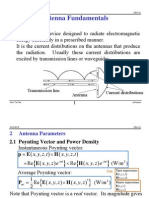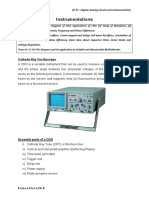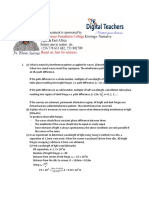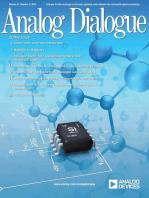0 ratings0% found this document useful (0 votes)
64 viewsLecture 1
This document describes an experiment to determine the velocity of sound in air using a cathode ray oscilloscope. Sound waves from a speaker transmitter are received by a microphone receiver, and the signals are fed into the oscilloscope. By varying the distance between the transmitter and receiver, straight lines with positive and negative slopes are obtained on the oscilloscope screen, allowing the half wavelength of the sound to be measured. Repeating this for different frequencies and plotting wavelength vs the reciprocal of frequency gives the velocity of sound.
Uploaded by
Ayan SantraCopyright
© Attribution Non-Commercial (BY-NC)
Available Formats
Download as PDF, TXT or read online on Scribd
0 ratings0% found this document useful (0 votes)
64 viewsLecture 1
This document describes an experiment to determine the velocity of sound in air using a cathode ray oscilloscope. Sound waves from a speaker transmitter are received by a microphone receiver, and the signals are fed into the oscilloscope. By varying the distance between the transmitter and receiver, straight lines with positive and negative slopes are obtained on the oscilloscope screen, allowing the half wavelength of the sound to be measured. Repeating this for different frequencies and plotting wavelength vs the reciprocal of frequency gives the velocity of sound.
Uploaded by
Ayan SantraCopyright
© Attribution Non-Commercial (BY-NC)
Available Formats
Download as PDF, TXT or read online on Scribd
You are on page 1/ 2
Lecture 1
Velocity of sound in air
Objective
To determine the velocity of sound in air at room temperature using a Cathode
Ray Oscilloscope.
Theory
If two sinusoidal inputs, say, y1 = a1 sin (et-o1) and y2 = a2 sin (et-o2) are fed to
the x-plates and y-plates of an Oscilloscope, the superimposed wave obtained in the
screen of the CRO would have the form (look up the method of superposition of
sinusoidal waves say, in Jenkins & White , Fundamentals of Optics):
sin
2
(o1 - o2) = y1
2
/a1
2
+ y2
2
/a2
2
- 2 (y1y2/(a1a2)) cos (o1 - o2) ------ (1)
where a and o represent the amplitude and phase of the two sinusoids respectively. If the
phase difference between these two waves S = (o1 - o2) is set to be an even multiple of
t, i.e., S = 2nt, then the above expression reduces to
sin
2
(o1 - o2) = sin
2
(2nt) = 0
y1
2
/a1
2
+ y2
2
/a2
2
- 2 (y1y2/(a1a2)) cos (2nt) = 0
(y1/a1 - y2/a2)
2
= 0
y1 = (a1/a2) y2 ------ (2)
which is the equation for a straight line. It can be shown that for S = (2n+1)t (i.e., for
odd multiples of t), equation (1) reduces to
y1 = - (a1/a2) y2 ------ (3)
which is again the equation for a straight line (but with a negative slope as compared to
equation 3.2).
Suppose that one of the two electrical signals, x, is derived from the audio generator
which is simultaneously connected to a transmitter T (speaker), as shown in Fig.9.1 and
the second one y is that of from the receiver R (microphone) placed in front of the
transmitter (at a certain distance). The transmitter will be emitting the sound waves of
frequency that of applied from the audio generator. The emitted sound waves propagating
in air is received by the receiver. In this case phase difference between the two signals
will depend on the path length traveled by the sound (in air) between transmitter and
receiver. If the path length is n (where is the wavelength of the sound wave traveling
in air) then the slope of the line displayed on the oscilloscope will be positive (eqn. 2) and
if it is
2
1 2 + n
then the display will be a straight line with negative slope (eqn. 3).
Therefore path difference between any two successive straight line is /2.
Fig 9.1
Procedure
1. Wire up the circuit as shown in figure.
2. Set the oscilloscope in xy mode and set the frequency of the audio oscillator (between
1-5KHz).
3. Adjust the amplitude of the sinusoidal input such that an ellipse is obtained on the
screen of the scope.
4. Keeping one speaker (T) fixed, move the microphone (receiver R) until the ellipse
collapses into a straight line. Note the distance between the two loudspeakers.
5. Move receiver R again and obtain the immediately next position for which a straight
line is once again obtained on the CRO screen. The distance between such successive
positions of the receiver corresponds to half-wavelength (/2) of the sound wave.
6. Take a average of many such /2 values and then obtain the wavelength
corresponding to the particular frequency.
7. Repeat observation for a few more frequency values.
8. Plot vs 1/v and obtain the velocity of sound from the graph.
Estimate the error in the measurement of velocity for each frequency.
Observations
Frequency = , Position of Transmitter T =
No. Position of the receiver R /2 (in m) Mean (m)
You might also like
- Hourglass Workout Program by Luisagiuliet 276% (21)Hourglass Workout Program by Luisagiuliet 251 pages
- The Hold Me Tight Workbook - Dr. Sue Johnson100% (16)The Hold Me Tight Workbook - Dr. Sue Johnson187 pages
- Read People Like A Book by Patrick King-Edited62% (66)Read People Like A Book by Patrick King-Edited12 pages
- Livingood, Blake - Livingood Daily Your 21-Day Guide To Experience Real Health77% (13)Livingood, Blake - Livingood Daily Your 21-Day Guide To Experience Real Health260 pages
- COSMIC CONSCIOUSNESS OF HUMANITY - PROBLEMS OF NEW COSMOGONY (V.P.Kaznacheev,. Л. V. Trofimov.)94% (212)COSMIC CONSCIOUSNESS OF HUMANITY - PROBLEMS OF NEW COSMOGONY (V.P.Kaznacheev,. Л. V. Trofimov.)212 pages
- Donald Trump & Jeffrey Epstein Rape Lawsuit and Affidavits83% (1016)Donald Trump & Jeffrey Epstein Rape Lawsuit and Affidavits13 pages
- The 36 Questions That Lead To Love - The New York Times94% (34)The 36 Questions That Lead To Love - The New York Times3 pages
- The 36 Questions That Lead To Love - The New York Times95% (21)The 36 Questions That Lead To Love - The New York Times3 pages
- Jeffrey Epstein39s Little Black Book Unredacted PDF75% (12)Jeffrey Epstein39s Little Black Book Unredacted PDF95 pages
- The 4 Hour Workweek, Expanded and Updated by Timothy Ferriss - Excerpt23% (954)The 4 Hour Workweek, Expanded and Updated by Timothy Ferriss - Excerpt38 pages
- Objectives:: T F (T) DT Area Ynder One Period PeriodNo ratings yetObjectives:: T F (T) DT Area Ynder One Period Period8 pages
- Interference Definition of Interference of Light: CrestNo ratings yetInterference Definition of Interference of Light: Crest5 pages
- Types of Beamforming: Adaptive AntennasNo ratings yetTypes of Beamforming: Adaptive Antennas33 pages
- Digital Oscillator: Final Mini Project Report OnNo ratings yetDigital Oscillator: Final Mini Project Report On10 pages
- Tutorial - 13 - Wave Reflection and Transmission at Normal IncidenceNo ratings yetTutorial - 13 - Wave Reflection and Transmission at Normal Incidence2 pages
- (Continued) : The Laws of Electromagnetism Maxwell's Equations Displacement CurrentNo ratings yet(Continued) : The Laws of Electromagnetism Maxwell's Equations Displacement Current21 pages
- AIPMT 2016 Physics Paper With Ans & Solution by Allen KotaNo ratings yetAIPMT 2016 Physics Paper With Ans & Solution by Allen Kota10 pages
- Climatronics' Novel Sonic Anemometer: U D/2 (1/t - 1/t)No ratings yetClimatronics' Novel Sonic Anemometer: U D/2 (1/t - 1/t)4 pages
- Images De-Noising With Mapshrink Estimate and Dual-Threshold in Curvelet DomainNo ratings yetImages De-Noising With Mapshrink Estimate and Dual-Threshold in Curvelet Domain5 pages
- Instrumentations: Cathode Ray OscilloscopeNo ratings yetInstrumentations: Cathode Ray Oscilloscope9 pages
- Johnson Noise and Shot Noise: Electronic Address: Dvp@mit - EduNo ratings yetJohnson Noise and Shot Noise: Electronic Address: Dvp@mit - Edu4 pages
- Lab 7 Dynamic Parameters of 2 Order Measurement SystemsNo ratings yetLab 7 Dynamic Parameters of 2 Order Measurement Systems6 pages
- Topic Determination of Source Parameters From Seismic SpectraNo ratings yetTopic Determination of Source Parameters From Seismic Spectra7 pages
- Feynman Lectures Simplified 2C: Electromagnetism: in Relativity & in Dense MatterFrom EverandFeynman Lectures Simplified 2C: Electromagnetism: in Relativity & in Dense MatterNo ratings yet
- Sparse Representation of Astronomical Images: Laura Rebollo-Neira and James BowleyNo ratings yetSparse Representation of Astronomical Images: Laura Rebollo-Neira and James Bowley24 pages






























































































